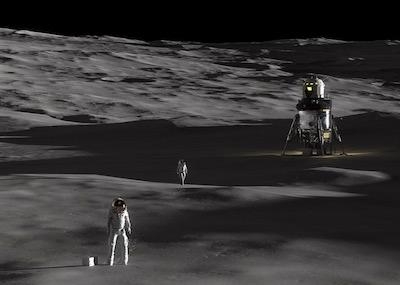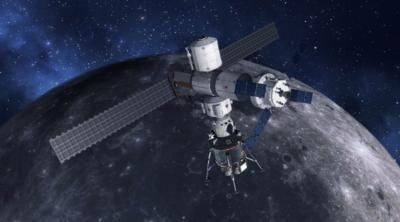Reusable Lander Could Take Astronauts From The Lunar Gateway To The Surface Of The Moon And Advance Technology Needed To Explore Mars
At the International Astronautical Congress (IAC) in Bremen, Germany, Lockheed Martin experts revealed the company's crewed lunar lander concept and showed how the reusable lander aligns with NASA's lunar Gateway and future Mars missions.

Lockheed Martin’s crewed lunar lander concept shows how to send astronauts to the surface of the Moon for sustainable exploration.
The crewed lunar lander is a single stage, fully reusable system that incorporates flight-proven technologies and systems from NASA's Orion spacecraft. In its initial configuration, the lander would accommodate a crew of four and 2,000 lbs. of cargo payload on the surface for up to two weeks before returning to the Gateway without refueling on the surface.
"NASA asked industry for innovative and new approaches to advance America's goal of returning humans to the Moon, and establishing a sustainable, enduring presence there," said Lisa Callahan, vice president and general manager of Commercial Civil Space at Lockheed Martin Space. "This is a concept that takes full advantage of both the Gateway and existing technologies to create a versatile, powerful lander that can be built quickly and affordably. This lander could be used to establish a surface base, deliver scientific or commercial cargo, and conduct extraordinary exploration of the Moon."
The unique orbit of the lunar Gateway provides global lunar access for a lander. Having the ability to visit multiple sites with a reusable lander supports many international, commercial, and scientific communities, in addition to NASA's sustainable exploration of the Moon. After a surface mission, it would return to the Gateway, where it can be refueled, serviced, and then kept in orbit until the next surface sortie mission.

"The Gateway is key to full, frequent and fast reusability of this lander," said Tim Cichan, space exploration architect at Lockheed Martin Space, who presented the lander concept at IAC. "Because this lander doesn't have to endure the punishment of re-entering Earth's atmosphere, it can be re-flown many times over without needing significant and costly refurbishment. That's a major advantage of the Gateway and of a modular, flexible, reusable approach to deep space exploration."
The investments made in technology developed for Orion can be re-used to reduce the cost, complexity and development timeline. Some of the human-rated, flight-proven systems used in the design include avionics, life support, communications and navigation systems, and a light-weight version of its crew module pressure vessel.
Reusable landers are enabled by the lunar Gateway and are important for sustainable exploration. Additionally, landed human lunar missions and a lunar orbiting outpost are valuable to prepare for sending humans to Mars. While the Moon doesn't have an atmosphere, there are still many lessons that apply to a future crewed Mars lander, such as: operations experience in a challenging and dynamic environment, operating and refueling out of orbit, long-duration cryogenic propulsion, and terminal descent navigation, guidance and control.
(Images provided with Lockheed Martin news release)
 Bolen Gives Congress a Rare Thumbs-Up
Bolen Gives Congress a Rare Thumbs-Up The SportPlane Resource Guide RETURNS!!!!
The SportPlane Resource Guide RETURNS!!!! Buying Sprees Continue: Textron eAviation Takes On Amazilia Aerospace
Buying Sprees Continue: Textron eAviation Takes On Amazilia Aerospace Hawker 4000 Bizjets Gain Nav System, Data Link STC
Hawker 4000 Bizjets Gain Nav System, Data Link STC Echodyne Gets BVLOS Waiver for AiRanger Aircraft
Echodyne Gets BVLOS Waiver for AiRanger Aircraft




